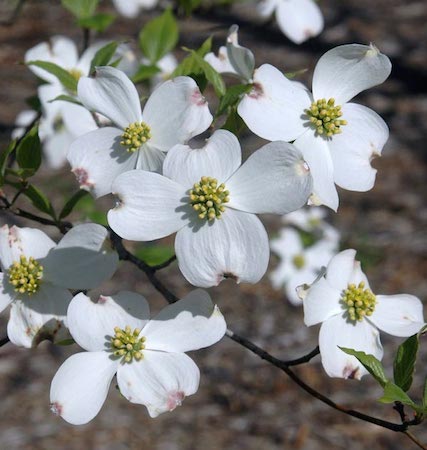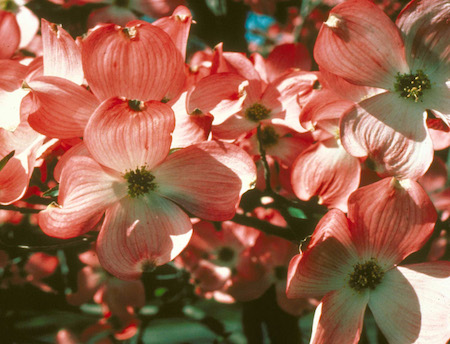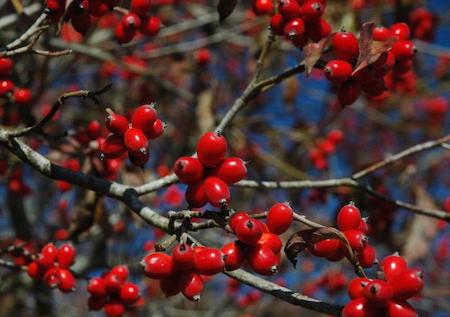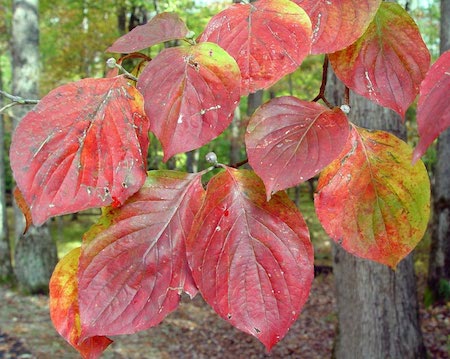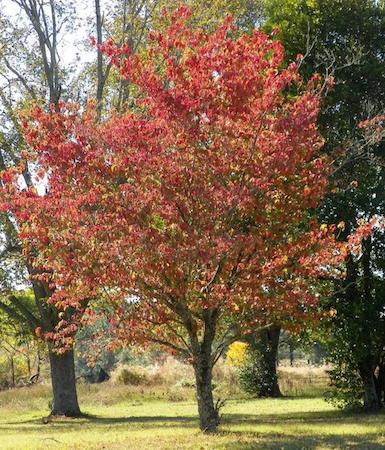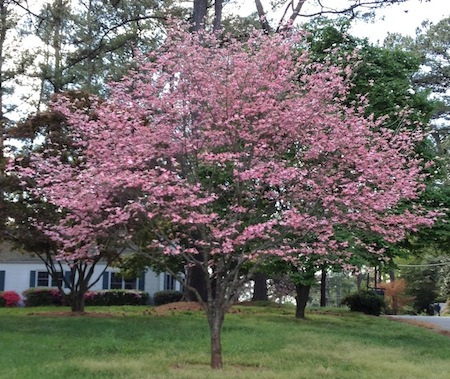Dogwood
Specifications
- Also known as: Flowering Dogwood
- Latin (scientific) name: Cornus florida. Cornus is Latin for a species of tree, the Cornelian-cherry of Europe, which has particularly hard wood; florida is Latin for flowering, referring to the white flowers (more precisely, bracts that look like petals).
- Life expectancy: 40 years
- Height: 45 feet
- Circumference: 39 inches
-
The height and circumference measurements listed above are for the largest-known flowering dogwood in Atlanta. This tree is located on private property.
-
Special characteristics:
Everyone eagerly awaits the blooming of the lovely dogwood tree in spring. Atlanta even has a “Dogwood Festival” to celebrate this event. Most trees have snow white blossoms, but the pink variety is just as showy. The flowers appear in mid-April, along with those of the azaleas. Talk about a color combination—it’s nothing short of stunning!
Dogwoods grow fairly quickly.They are shade tolerant; that is, they readily grow under the canopy of other, larger trees. Dogwoods also like a sunny location, so they can be planted just about anywhere.
-
Annoyance factors:
The dogwood is another of those trees that you fall in love with but may lose in your lifetime. It has a short life span. When mature and at the peak of their beauty, dogwoods are also most vulnearable to fatal conditions such as attack by a particular type of leaf fungus called anthracnose. There are several varieties of anthracnose, only one of which is lethal. Your tree inspector should be able to tell you which variety is attacking your tree.
(Another kind of dogwood, the Kousa, [or Korean] dogwood [Cornus kousa], is similar in appearance to the flowering dogwood. It is much less susceptible to anthracnose.)
Low drought tolerance. Dogwood tree roots grow right at the surface of the ground. This makes them highly susceptible to drought damage.
-
Fun Facts:
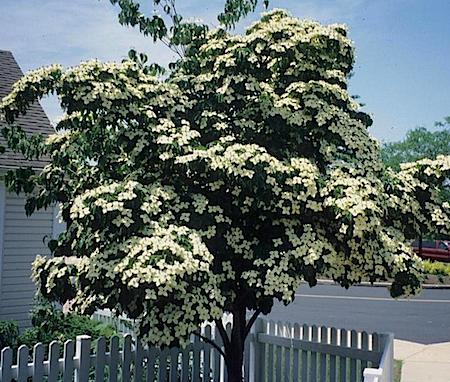 Kousa dogwoodWhen someone loses their beloved flowering dogwood tree, we suggest replacing it with a Kousa dogwood (at right). The Kousa blooms about a month later than the more common dogwood, in mid- to late May. We suggest to folks that they not tell their neighbors and friends what kind of dogwood they planted (let them discover the difference!); but tell them instead you have a secret formula, handed down through several generations, that prolongs their bloom timing. Think up a bizarre concoction (if you are so kind as to reveal your secret) and ramp up your exaggerations during the conversation. How far can you take them on your imaginary tall tale? There’s only one way to find out. Oh yes, a straight face gets you longer mileage.
Kousa dogwoodWhen someone loses their beloved flowering dogwood tree, we suggest replacing it with a Kousa dogwood (at right). The Kousa blooms about a month later than the more common dogwood, in mid- to late May. We suggest to folks that they not tell their neighbors and friends what kind of dogwood they planted (let them discover the difference!); but tell them instead you have a secret formula, handed down through several generations, that prolongs their bloom timing. Think up a bizarre concoction (if you are so kind as to reveal your secret) and ramp up your exaggerations during the conversation. How far can you take them on your imaginary tall tale? There’s only one way to find out. Oh yes, a straight face gets you longer mileage.The flowering dogwood provides a valuable source of food for wildlife. You’ll see a variety of birds foraging this tree when the seeds are a rich red color.
Flowering dogwood is tough wood. It is stronger than oak, and has a high resiliency to shock impact, making it a good choice for golf club heads. Woodworkers prize this wood for chisel handles because it doesn’t “broom” at the end after repeated pounding of the mallet. In the old days, the wood was used for hay forks, barrel hoops, spindles, hubs for small wheels, machinery bearings, and hog yokes.
-
Photo Credits:
White flowers: Wendy VanDyk Evans, Bugwood.org
Pink flowers: Robert L. Anderson, USDA Forest Service, Bugwood.org
Bark and Fall leaves: Chris Evans, University of Illinois, Bugwood.org
Berries: David J. Moorhead, University of Georgia, Bugwood.org
Tree: Karan A. Rawlins, University of Georgia, Bugwood.orgKousa Dogwood: Richard Webb, Bugwood.org

